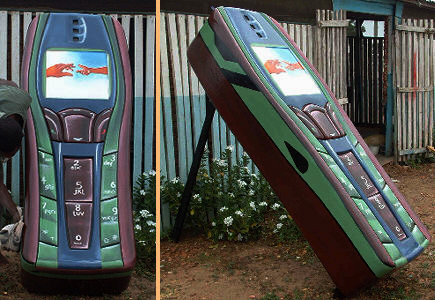Pastor Williams Ofori-Attah’s Sunday sermon struck a chord his countrymen are all too familiar with, lavish funerary spending.

“Keep your line to heaven open – go to the afterlife in a Nokia,” reads an African website that sells fantasy coffins. “The face of the phone opens to make the lid. Whatever brand you want our carpenters can make it for you – even blue tooth!” (Photo courtesy of www.eshopafrica.com)
“Children of the dead must not be compelled to do things which their resources cannot meet,” said Ofori-Attah, according to a Ghana News Agency article.
“How can the people of a nation, which is fighting to reduce poverty, continue to dissipate valuable resources on funerals,” the preacher asked.
Ofori-Attah is a leader in the Church of Pentecost in Ghana, a West African country whose Ga people spend half a year’s salary on some funerals. Rites include a procession of gyrating mourners that knock on the doors of both friends and enemies of the deceased, whom are transported in fantasy coffins, handcraft caskets that can take the shape of anything from a passenger jet to a uterus.
“These are not just quirky contemporary art pieces,” says Christine Mullen Kreamer, a curator at the National Museum of African Art, in Washington D.C, “they fit very clearly into a longer tradition of funerary practices.”
Celebratory and stylish send offs pervade the African continent but the Ga, who craft their wares in open-air shops in Teshie-Nungua, a suburb of the capitol city of Accra, have taken their handiwork global.
Special coffin orders include a Nokia mobile phone and a full-sized Ferrari by an art gallery in Moscow, a Teddy Bear by a Dutch web company, the Empire State Building by a New York journalist and a half-sized Subaru Impreza by Top Gear, a British auto show. Other shapes that have drawn attention: a carrot, a pineapple, okra, a pile of cloth, a machine gun barrel, a handsaw, a carpenter’s vice, a gas truck, a beer bottle and a cigarette. Coffins can be associated with vocation, but also a vice, or a wish. “Someone buried in a KLM airplane coffin does not mean that person was a pilot, or has ever even flown,” says Kreamer, “but may mean the person has always wanted to travel.”
The most well-known fantasy coffin carpenter is Kane Quaye, who introduced them to the world at a 1989 exhibition in Paris called “Magiciens de la Terre” (Magicians of the Earth). Kreamer co-authored a 1994 book on Quaye called “A Life Well Lived: Fantasy Coffins of Kane Quay”. His coffins have been exhibited at galleries from Moscow to New York, 12 are in a permanent exhibit at the National Museum of Funeral History, in Houston, Texas.
But not all Ghanaians agree with fantasy coffins. “The dimension which contemporary Ghanaian funerals have assumed over the last decade gives a great cause for concern if not worry,” notes one Ghanaian newspaper columnist, in a 2007 article that accuses politicians of perpetrating unsound funeral customs. “Consciously or unconsciously,” notes the columnist, “we seem to measure the efficiency of a minister or Member of Parliament by the number of funerals he attends every weekend!”
And for the church the practice can be excessive too. “Imagine going through a town of people and everyone singing, clapping, drumming, doing who knows what, like a big Mardi Gras parade,” said Kreamer. “That doesn’t necessarily fit with the staid celebration or prayerful event that one might adopt with a more organized Western Christian practice.”
But funeral flair lies closer to home than we might think. Just this week a New York Times article noted that, given the tough economic times, funeral directors are offering customers more specialized funerary services, such as sports-themed urns, hearses towed by Harley-Davidsons (for bikers), and funeral guides that come with wildflower seeds (for gardeners).
Ironically, when Quaye passed away in 1992, he chose not to be buried in a fantasy coffin. Instead, his children etched into the side of a normal wooden casket the simple tools of their father’s trade, a saw, a plane, a level.










perfect acai review
That’s reallya great museum. When I was there back in 2002 I learned alot. Such awesomeexhibits.